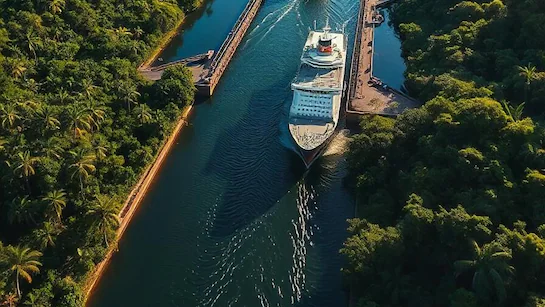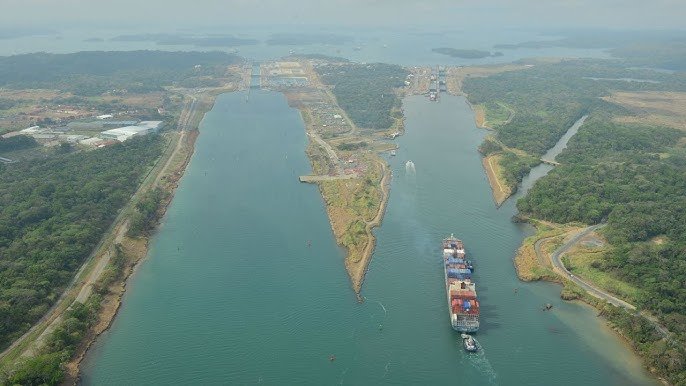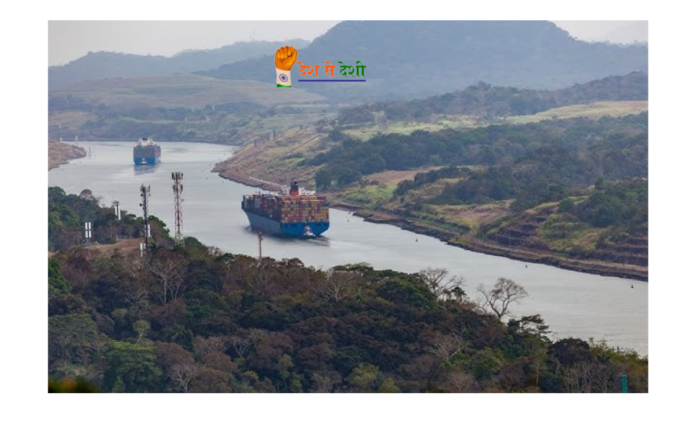When you think of monumental feats of engineering, the Panama Canal undoubtedly comes to mind. This waterway, which stretches across the narrow Isthmus of Panama in Central America, has long been recognized as one of the most significant engineering achievements in history. But while its global importance is unquestionable, many might still ask: Where exactly is the Panama Canal, and why does it hold such an indispensable place in modern trade and geopolitics?
A Narrow Stretch with Global Implications
The Panama Canal is located in the country of Panama, which forms the land bridge between North and South America. The canal itself stretches approximately 50 miles (80 kilometers) from the city of Colón on the Caribbean Sea to the city of Balboa on the Pacific Ocean. It cuts across the Isthmus of Panama, a narrow strip of land that connects the two continents. The canal runs through the tropical rainforest region, passing through dense forests and the famous Gatun Lake, which serves as a crucial reservoir for its operation.
The strategic location of the Panama Canal makes it one of the most valuable and contested waterways in the world. It allows ships to bypass the long and treacherous journey around the southern tip of South America, particularly Cape Horn, which can add days or even weeks to a ship’s voyage. By linking the Pacific and Atlantic Oceans, the canal has become a vital conduit for global trade, enabling the swift movement of goods and commodities between the east and west coasts of the Americas.
A Storied History
The story of the Panama Canal is one of ambition, struggle, and triumph. The concept of a waterway connecting the two oceans was first proposed by the French in the early 19th century, driven by the desire to facilitate quicker trade routes and ease military movements between the two oceans. French engineer Ferdinand de Lesseps, famous for his role in the Suez Canal, spearheaded the initial project in the 1880s. However, due to technical difficulties, mismanagement, and a high death toll from diseases like malaria and yellow fever, the French effort ultimately failed.
It was only after the U.S. took control of the project in the early 1900s that the dream of the Panama Canal began to materialize. The U.S. had a vested interest in ensuring that the canal became a reality for military and commercial reasons. By 1904, the U.S. had signed a treaty with Panama, giving the U.S. control of the canal zone, and construction of the canal began in earnest.
The project faced monumental engineering challenges, including the need to excavate mountains, build complex locks, and deal with diseases that ravaged the workers. Over the course of more than a decade, thousands of laborers—many of them workers from the Caribbean—were employed to complete the canal. It finally opened in 1914, forever changing global trade and shipping patterns.
The Mechanics of the Canal: How Does It Work?
At its core, the Panama Canal is a lock-based waterway that allows ships to traverse a dramatic change in elevation. The canal connects the Pacific Ocean, which is at sea level, with the Caribbean Sea, which is also at sea level, but the land between them rises over 500 feet above sea level at certain points. This means that ships must ascend and descend through a series of locks to navigate the canal.
There are three sets of locks on the Panama Canal: the Gatun Locks (on the Atlantic side), the Pedro Miguel Locks (on the Pacific side), and the Miraflores Locks (also on the Pacific side). When a ship enters a lock, water is either pumped into the chamber to raise the ship or drained out to lower the ship. This process enables the vessel to pass through the canal at different elevations without needing to travel around the entire continent.

The Gatun Lake, which was artificially created during the construction of the canal, plays a critical role in regulating water levels and providing the necessary water to operate the locks. The canal’s lock system is a true engineering marvel, requiring careful management of water levels and precise timing to accommodate the flow of ships.
The Modern-Day Panama Canal
In the 21st century, the Panama Canal remains a key player in the global shipping industry. It is one of the busiest shipping lanes in the world, handling around 12,000 transits annually. The canal facilitates the transport of a vast array of goods, from oil and agricultural products to consumer electronics and automobiles. For ships traveling between the Atlantic and Pacific, there is no faster route, making it an essential link in international commerce.

In recent years, the canal underwent a massive expansion project, known as the Third Set of Locks. Completed in 2016, this expansion allowed for the passage of larger ships—known as “Panamax” vessels—that were previously too large to fit through the original locks. The new locks, which are able to handle “New Panamax” or “Post-Panamax” vessels, have dramatically increased the canal’s capacity and are expected to further enhance its role in global trade.
The expansion has also allowed the canal to handle an increasing volume of goods coming from Asia, especially China. With the rise of global trade and China’s Belt and Road Initiative, the Panama Canal has become even more important as a critical link in the international shipping chain. The ability to accommodate larger vessels has made it a central hub for goods traveling between the Pacific and Atlantic, benefiting countries on both sides of the Americas.
Geopolitical Importance
Beyond its economic significance, the Panama Canal has also been a point of geopolitical contention throughout history. Its control has been a subject of intense debate, particularly during the 20th century, when the U.S. sought to maintain its dominance over the canal. In 1999, the U.S. handed control of the canal over to Panama, but it remains a key point in U.S. military strategy due to its strategic location and importance in maritime trade.
In recent years, China has been making significant inroads in Latin America, with increasing investments in infrastructure and trade. Its involvement in Panama, particularly regarding the canal, has raised concerns in the U.S., which sees the canal as a vital link in maintaining its influence over the Western Hemisphere.
Also read: Trump Targets Panama Canal: A Strategic Swipe at China
The Future of the Canal
Looking ahead, the Panama Canal will likely remain a central player in the global economy. As international trade continues to grow, the canal’s capacity will be tested, and the need for upgrades and improvements will only increase. The canal will also continue to be an important piece in the larger geopolitical chess game, as nations vie for influence in the region.
The Panama Canal is not just a waterway—it is a symbol of human ingenuity, resilience, and ambition. It is a testament to the power of engineering to reshape the world, and it remains a critical asset for global trade, ensuring that goods and commodities continue to flow between the East and West with efficiency and speed.
In short, the Panama Canal is much more than a location—it is a pivotal global artery, connecting the world in ways that continue to shape the course of history.




